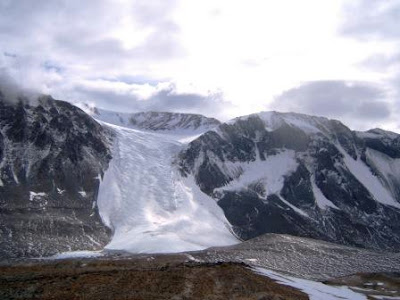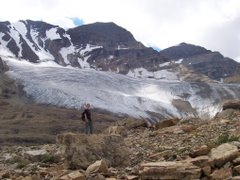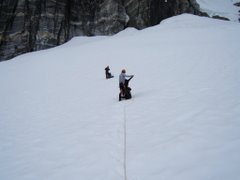a.
 b.
b. c.
c. d.
d. e.
e. f.
f. g.
g. h.
h. i.
i.
Adventures of an environmental geochemist
 To get there, we hiked up the western margin of Canada Glacier, a feat that required stablizers to handle the refrozen snow. Stabilizers are like strap on sandals that have screws sticking out the bottom to minimize slipping. The don't have front points like crampons and can only handle minimal changes in topography. Without them, you would slide not so gracefully into the side of the glacier like a lost seal trying to find its way back to the sea... Once we were parallel with the base of the icefall, we crossed the glacier across a flagged route (we crossed this way, because the GA, Matt, had not used crampons before and this is the approved route for non-glacier crews using stabilizers).
To get there, we hiked up the western margin of Canada Glacier, a feat that required stablizers to handle the refrozen snow. Stabilizers are like strap on sandals that have screws sticking out the bottom to minimize slipping. The don't have front points like crampons and can only handle minimal changes in topography. Without them, you would slide not so gracefully into the side of the glacier like a lost seal trying to find its way back to the sea... Once we were parallel with the base of the icefall, we crossed the glacier across a flagged route (we crossed this way, because the GA, Matt, had not used crampons before and this is the approved route for non-glacier crews using stabilizers). My flat friends waddled slowly behind us, wading up to their bellies in the high amount of snow that has fallen this spring/summer. (Normally, the Taylor Valley averages around 10 cm/yr of snow- but it looks as though at least that has fallen in the past month).
My flat friends waddled slowly behind us, wading up to their bellies in the high amount of snow that has fallen this spring/summer. (Normally, the Taylor Valley averages around 10 cm/yr of snow- but it looks as though at least that has fallen in the past month). Here is our view on the east side of the glacier, before we headed down to the lake.
Here is our view on the east side of the glacier, before we headed down to the lake. At the end of the day, we had a nice cup of tea from the melt of glacier berries (above in the crate, and below along the margin of the glacier). Until Lake Hoare moats opens up, glacier berries are the preferred source of drinking water. Also, Lake Hoare is the only 'freshwater' lake that we can drink from in the valleys. The rest are quite salty including the magnesium-rich lake mistakenly savored by early valley researchers that was aptly named Lake Chad.
At the end of the day, we had a nice cup of tea from the melt of glacier berries (above in the crate, and below along the margin of the glacier). Until Lake Hoare moats opens up, glacier berries are the preferred source of drinking water. Also, Lake Hoare is the only 'freshwater' lake that we can drink from in the valleys. The rest are quite salty including the magnesium-rich lake mistakenly savored by early valley researchers that was aptly named Lake Chad.







 The winds are light today, but no flights again do to the sustained gray. There is little chance that today will be the day that Andersen Creek melts... so I will take a hike today after a few hours on my dissertation. I sit comfortably inside Lake Hoare Camp now. Looking out upon this gray day with anticipation.
The winds are light today, but no flights again do to the sustained gray. There is little chance that today will be the day that Andersen Creek melts... so I will take a hike today after a few hours on my dissertation. I sit comfortably inside Lake Hoare Camp now. Looking out upon this gray day with anticipation. 
 The glaciers of the dry valleys are unique, they are not experiencing the rapid retreat of their temperate and tropical counterparts. The rest of the mountain glaciers of the world have accelerated in their demise, especially it seems within the last decade (from what you can see from the photographs and moraines (rocks left by receding glaciers) left identifying glaciers used to be). What used to be snow is now falling as rain at higher and higher altitudes. This is a big concern to people reliant on glacier melt for drinking water, crops and energy. Especially areas with dry summers and little other water. (Snowpack is similarly important).
The glaciers of the dry valleys are unique, they are not experiencing the rapid retreat of their temperate and tropical counterparts. The rest of the mountain glaciers of the world have accelerated in their demise, especially it seems within the last decade (from what you can see from the photographs and moraines (rocks left by receding glaciers) left identifying glaciers used to be). What used to be snow is now falling as rain at higher and higher altitudes. This is a big concern to people reliant on glacier melt for drinking water, crops and energy. Especially areas with dry summers and little other water. (Snowpack is similarly important). Above and below are shots of the Canada Glacier.
Above and below are shots of the Canada Glacier.
 While I wrote, the Frankenberg Fish went back to the Suess Glacier for a glamor shot. I realize that I am not writing this for kids (but hope the pictures entertain).
While I wrote, the Frankenberg Fish went back to the Suess Glacier for a glamor shot. I realize that I am not writing this for kids (but hope the pictures entertain).
 In the meantime the Flats found a dry patch and a mummified seal that had lost its way back to the Ross Sea and wandered inland instead. They were not sure what to make of this poor creature.
In the meantime the Flats found a dry patch and a mummified seal that had lost its way back to the Ross Sea and wandered inland instead. They were not sure what to make of this poor creature. It feels even more remote here with snow because all Helicopter traffic stops (not that there is a lot, but 2 or 3 a day is a beacon connecting us with McMurdo).
It feels even more remote here with snow because all Helicopter traffic stops (not that there is a lot, but 2 or 3 a day is a beacon connecting us with McMurdo). 


